Various - Birds, Illustrated by Color Photography, Vol. 1, No. 3
Здесь есть возможность читать онлайн «Various - Birds, Illustrated by Color Photography, Vol. 1, No. 3» — ознакомительный отрывок электронной книги совершенно бесплатно, а после прочтения отрывка купить полную версию. В некоторых случаях можно слушать аудио, скачать через торрент в формате fb2 и присутствует краткое содержание. Жанр: periodic, Биология, Природа и животные, foreign_edu, на английском языке. Описание произведения, (предисловие) а так же отзывы посетителей доступны на портале библиотеки ЛибКат.
- Название:Birds, Illustrated by Color Photography, Vol. 1, No. 3
- Автор:
- Жанр:
- Год:неизвестен
- ISBN:нет данных
- Рейтинг книги:4 / 5. Голосов: 1
-
Избранное:Добавить в избранное
- Отзывы:
-
Ваша оценка:
- 80
- 1
- 2
- 3
- 4
- 5
Birds, Illustrated by Color Photography, Vol. 1, No. 3: краткое содержание, описание и аннотация
Предлагаем к чтению аннотацию, описание, краткое содержание или предисловие (зависит от того, что написал сам автор книги «Birds, Illustrated by Color Photography, Vol. 1, No. 3»). Если вы не нашли необходимую информацию о книге — напишите в комментариях, мы постараемся отыскать её.
Birds, Illustrated by Color Photography, Vol. 1, No. 3 — читать онлайн ознакомительный отрывок
Ниже представлен текст книги, разбитый по страницам. Система сохранения места последней прочитанной страницы, позволяет с удобством читать онлайн бесплатно книгу «Birds, Illustrated by Color Photography, Vol. 1, No. 3», без необходимости каждый раз заново искать на чём Вы остановились. Поставьте закладку, и сможете в любой момент перейти на страницу, на которой закончили чтение.
Интервал:
Закладка:
Various
Birds, Illustrated by Color Photography, Vol. 1, No. 3 / March 1897
LITTLE BOY BLUE
Boys and girls, don’t you think that is a pretty name? I came from the warm south, where I went last winter, to tell you that Springtime is nearly here.
When I sing, the buds and flowers and grass all begin to whisper to one another, “Springtime is coming for we heard the Bluebird say so,” and then they peep out to see the warm sunshine. I perch beside them and tell them of my long journey from the south and how I knew just when to tell them to come out of their warm winter cradles. I am of the same blue color as the violet that shows her pretty face when I sing, “Summer is coming, and Springtime is here.”
I do not like the cities for they are black and noisy and full of those troublesome birds called English Sparrows. I take my pretty mate and out in the beautiful country we find a home. We build a nest of twigs, grass and hair, in a box that the farmer puts up for us near his barn.
Sometimes we build in a hole in some old tree and soon there are tiny eggs in the nest. I sing to my mate and to the good people who own the barn. I heard the farmer say one day, “Isn’t it nice to hear the Bluebird sing? He must be very happy.” And I am, too, for by this time there are four or five little ones in the nest.
Little Bluebirds are like little boys – they are always hungry. We work hard to find enough for them to eat. We feed them nice fat worms and bugs, and when their little wings are strong enough, we teach them how to fly. Soon they are large enough to hunt their own food, and can take care of themselves.
The summer passes, and when we feel the breath of winter we go south again, for we do not like the cold.
I know the song that the Bluebird is singing
Out in the apple tree, where he is swinging.
Brave little fellow! the skies may be dreary,
Nothing cares he while his heart is so cheery.
Hark! how the music leaps out from his throat,
Hark! was there ever so merry a note?
Listen a while, and you’ll hear what he’s saying,
Up in the apple tree swinging and swaying.
“Dear little blossoms down under the snow,
You must be weary of winter, I know;
Hark! while I sing you a message of cheer,
Summer is coming, and springtime is here!”
“Dear little snow-drop! I pray you arise;
Bright yellow crocus! come open your eyes;
Sweet little violets, hid from the cold,
Put on our mantles of purple and gold;
Daffodils! daffodils! say, do you hear,
Summer is coming! and springtime is here!”
THE BLUE BIRD
Winged lute that we call a blue bird,
You blend in a silver strain
The sound of the laughing waters,
The patter of spring’s sweet rain,
The voice of the wind, the sunshine,
And fragrance of blossoming things,
Ah! you are a poem of April
That God endowed with wings.
LIKE a bit of sky this little harbinger of spring appears, as we see him and his mate househunting in early March. Oftentimes he makes his appearance as early as the middle of February, when his attractive note is heard long before he himself is seen. He is one of the last to leave us, and although the month of November is usually chosen by him as the fitting time for departure to a milder clime, his plaintive note is quite commonly heard on pleasant days throughout the winter season, and a few of the braver and hardier ones never entirely desert us. The Robin and the Blue Bird are tenderly associated in the memories of most persons whose childhood was passed on a farm or in the country village. Before the advent of the English Sparrow, the Blue Bird was sure to be the first to occupy and the last to defend the little box prepared for his return, appearing in his blue jacket somewhat in advance of the plainly habited female, who on her arrival quite often found a habitation selected and ready for her acceptance, should he find favor in her sight. And then he becomes a most devoted husband and father, sitting by the nest and warbling with earnest affection his exquisite tune, and occasionally flying away in search of food for his mate and nestlings.
The Blue Bird rears two broods in the season, and, should the weather be mild, even three. His nest contains three eggs.
In the spring and summer when he is happy and gay, his song is extremely soft and agreeable, while it grows very mournful and plaintive as cold weather approaches. He is mild of temper, and a peaceable and harmless neighbor, setting a fine example of amiability to his feathered friends. In the early spring, however, he wages war against robins, wrens, swallows, and other birds whose habitations are of a kind to take his fancy. A celebrated naturalist says: “This bird seems incapable of uttering a harsh note, or of doing a spiteful, ill-tempered thing.”
Nearly everybody has his anecdote to tell of the Blue Bird’s courage, but the author of “Wake Robin” tells his exquisitely thus: “A few years ago I put up a little bird house in the back end of my garden for the accommodation of the wrens, and every season a pair have taken up their abode there. One spring a pair of Blue Birds looked into the tenement, and lingered about several days, leading me to hope that they would conclude to occupy it. But they finally went away. Late in the season the wrens appeared, and after a little coquetting, were regularly installed in their old quarters, and were as happy as only wrens can be. But before their honeymoon was over, the Blue Birds returned. I knew something was wrong before I was up in the morning. Instead of that voluble and gushing song outside the window, I heard the wrens scolding and crying out at a fearful rate, and on going out saw the Blue Birds in possession of the box. The poor wrens were in despair and were forced to look for other quarters.”
THE SWALLOW
“Come, summer visitant, attach
To my reedroof thy nest of clay,
And let my ear thy music catch,
Low twitting underneath the thatch,
At the gray dawn of day.”
SURE harbingers of spring are the Swallows. They are very common birds, and frequent, as a rule, the cultivated lands in the neighborhood of water, showing a decided preference for the habitations of man. “How gracefully the swallows fly! See them coursing over the daisy-bespangled grass fields; now they skim just over the blades of grass, and then with a rapid stroke of their long wings mount into the air and come hovering above your head, displaying their rich white and chestnut plumage to perfection. Now they chase each other for very joyfulness, uttering their sharp twittering notes; then they hover with expanded wings like miniature Kestrels, or dart downwards with the velocity of the sparrowhawk; anon they flit rapidly over the neighboring pool, occasionally dipping themselves in its calm and placid waters, and leaving a long train of rings marking their varied course. How easily they turn, or glide over the surrounding hedges, never resting, never weary, and defying the eye to trace them in the infinite turnings and twistings of their rapid shooting flight. You frequently see them glide rapidly near the ground, and then with a sidelong motion mount aloft, to dart downwards like an animated meteor, their plumage glowing in the light with metallic splendor, and the row of white spots on the tail contrasting beautifully with the darker plumage.”
The Swallow is considered a life-paired species, and returns to its nesting site of the previous season, building a new nest close to the old one. His nest is found in barns and outhouses, upon the beams of wood which support the roof, or in any place which assures protection to the young birds. It is cup-shaped and artfully moulded of bits of mud. Grass and feathers are used for the lining. “The nest completed, five or six eggs are deposited. They are of a pure white color, with deep rich brown blotches and spots, notably at the larger end, round which they often form a zone or belt.” The sitting bird is fed by her mate.
Читать дальшеИнтервал:
Закладка:
Похожие книги на «Birds, Illustrated by Color Photography, Vol. 1, No. 3»
Представляем Вашему вниманию похожие книги на «Birds, Illustrated by Color Photography, Vol. 1, No. 3» списком для выбора. Мы отобрали схожую по названию и смыслу литературу в надежде предоставить читателям больше вариантов отыскать новые, интересные, ещё непрочитанные произведения.
Обсуждение, отзывы о книге «Birds, Illustrated by Color Photography, Vol. 1, No. 3» и просто собственные мнения читателей. Оставьте ваши комментарии, напишите, что Вы думаете о произведении, его смысле или главных героях. Укажите что конкретно понравилось, а что нет, и почему Вы так считаете.
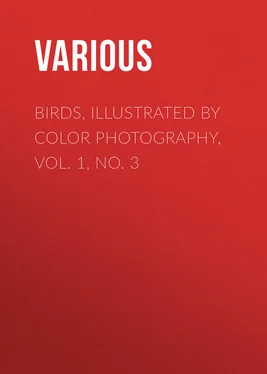



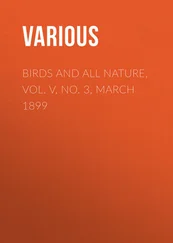
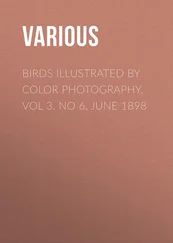
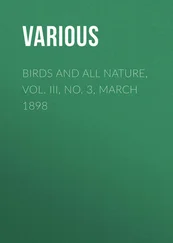
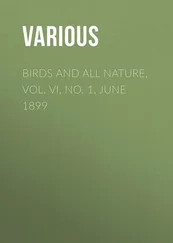
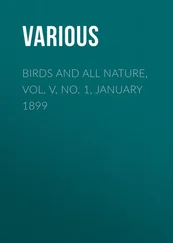

![Various - Birds Illustrated by Color Photography [January, 1898]](/books/746296/various-birds-illustrated-by-color-photography-ja-thumb.webp)

![Various - Birds Illustrated by Color Photography [February, 1898]](/books/746443/various-birds-illustrated-by-color-photography-fe-thumb.webp)